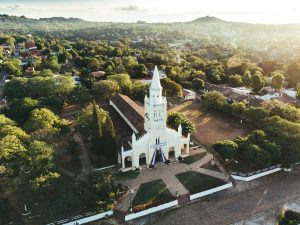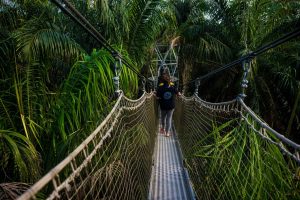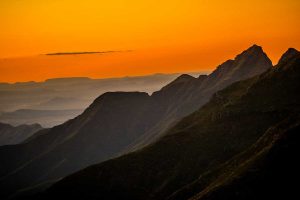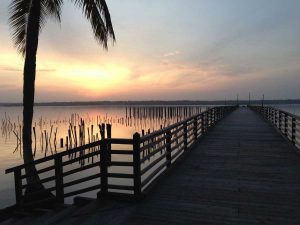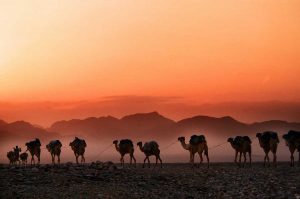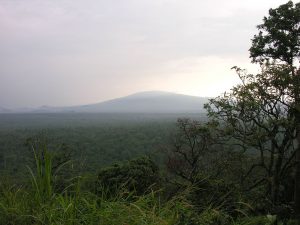The country’s name originates from the Senegal River in the north, which is the largest river in the country. Also the river Casamance in the southern tropical climate region. Senegal is mainly a low-lying country, with forests in the southwest and semi deserts in the northern areas. Here, the official language is French, while there are other indigenous languages also spoken – Wolof, Pulaar, Jola and Mandrika.
There is a tropical climate that is dominated by the hot and humid season and the rainy reason. Overall, there is a pleasant heat all year around. The country exports fish, cottons, fabrics and more, while the main industry focuses on textiles, mining, food processing etc. The country has also for a long time been dependent on peanuts. The vast majority of the population practices islam.
The lake Retba
Less than an hour away from Senegal’s capital city, there is an unusual lake that will surely catch the eye of every visitor because of its unusual pink color. Lake Retba is separated only by a few narrow dunes from the Atlantic ocean and is expected to have a very high salt content. Its salinity content is comparable to the dead sea and during the dry season it even exceeds it! Its distinct pink color is caused by the bacteria Dunaliella salina, which is attracted by the salt content of the lake. The bacteria produces a red pigment to absorb the sunlight, giving the lake its unique color. Its color is particularly visible during the dry season and less during the rainy season.
The IFAN Museum of African art
The museum ‘s remarkable collection presents an important insight into the history of West Africa and the visual cultures that make up the region. Ritual masks, tools, clothing, and weapons occupy the IFAN Museum, one of the oldest and most prominent institutions dedicated to the research and exhibition of West African art and artifacts. Founded in 1936, the museum was formerly called Le Musée d’Art Africain de L’Institute Fondamental d’Afrique Noire Cheikh Anta Diop IFAN / CAD and then The Théodore Monod African Art Museum. It was notably supported by the first Senegalese president, Léopold Senghor, who served between 1960 and 1980.
The great mosque of Touba
At the heart of the holy city of Mouride lies its Great Mosque, which is thought to be one of the largest in Africa. It has been continuously enlarged and embellished since its completion in 1963. The mosque has five minarets and three large domes and is the place where Amadou Bamba, founder of the Mouride brotherhood, is buried. The 87-meter (285 ft ) high central minaret mosque, called Lamp Fall, is one of Senegal’s most famous monuments. The name Lamp Fall refers to Sheik Ibrahima Fall, one of Bamba’s most influential disciples. The mosque is frequently visited by tourists and worshippers alike. The immediate vicinity of the mosque is the home of the mausoleum of the sons of Aamadu Bàmba, the caliphs of the Mouride order. The immediate vicinity of the mosque is the home of the mausoleum of the sons of Aamadu Bàmba, the caliphs of the Mouride order. Other important institutions in the center of the Holy City include the Library, the Caliph ‘s Official Audience Hall, the Holy Well of Mercy, and the Cemetery. Shaykh Sidy Mokhtar Mbacké is the current leader of the Mourids. He is the seventh Caliph of Mouridism and the second Caliph to not be the son of Ahmadu Bamba Mbacké. Like his predecessors, he resides in a large area on the main square facing the Mosque.
Saint Louis du Senegal during the Jazz Festival
Saint-Louis is known for its colonial history and unique island setting, but over the last three decades, the city has become synonymous with jazz. Hosting a myriad of global stars, festival-goers, nationalities, languages, and cultures, the Saint-Louis Jazz Festival is the largest in Africa. The festival itself is considered to be the “most beautiful jazz festival in Senegal’s most beautiful city” and it’s hard to find fault with that assessment. Its stage is the former capital of French West Africa: a historic island-city and UNESCO World Heritage Site, full of colorful colonial architecture and surrounded by the Senegal River Estuary. The festival’s atmosphere spreads across the city, with live events taking place in bars, galleries, cafes, and hotels. Its musicians come from all over the world, bringing their unique rhythms, languages, and cultures to the ears and eyes of tourists and locals. This is a festival that embodies the spirit of the city like no other.
Monument de la Renaissance Africaine
Big, bronze, and bullish, the African Renaissance Monument is the highest statue in Africa. Completed in 2010, the sculpture of man, woman, and child is a symbol of defiance and future prosperity, yet it has been widely criticized both before and after its construction. This is the bizarre story of this famous, imposing monument. The African Renaissance Monument is 49 meters taller than both the Statue of Liberty and Christ the Redeemer. Located on a 100-meter-high hill, it dominates the Dakar skyline and is supposed to represent Africa, taking “its destiny into its own hands.” According to former Senegalese President Abdoulaye Wade, who commissioned the project, the monument is synonymous with the “greatness, stability and durability” of the continent after “several centuries of imprisonment.” It’s official opening on 14 April 2010 – 50 years after Senegal gained independence from France – was supposed to be part of that narrative.
Eswatini (Swaziland)
Eswatini, formerly known as Swaziland is a small country located in South Africa. The country is a monarchy and King Mswati III decided to change the name of the country to distance further from the fact that the country was a British colony. Eswatini inhabits around 1.1 million people.
Tree Canopy Tour
In Sihlotswane gorge, located within the Mahololotaja nature reserve, people from all over the world travel to take part in a breath-taking Zip Line experience. The adventure includes zip-lining some ropes which are over 300 meters long. Excellent guides and astounding views are certain for the people visiting.
The Marula Festival in Eswatini
The Marula season begins each year in mid-February and continues until May, bringing with it a celebration of the harvest of the marula fruit. The fruits are used to make “Baruga”, or Marula beer. The people of Zimbabwe celebrate this harvest with small or bigger festivals locally all around the country. The King of Eswatini and his wives usually travel around their kingdom and take part in the traditional festivities.
Mountain Bike Races
Eswatini has developed as a worldwide attraction for the avid cyclist, both amateur and pro, as the country hosts a variety of mountain bike races. The annual IMVELO Classic is the biggest and most popular biking event, and takes place each June in Mlilwane Wildlife Sanctuary.
Eswatini has a number of mountain biking events throughout the year, including INYATSI Swazi Frontier and Imevelo MTB Classic.



